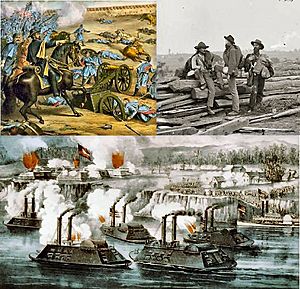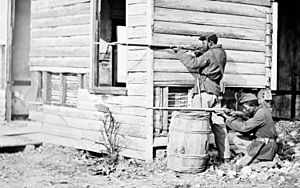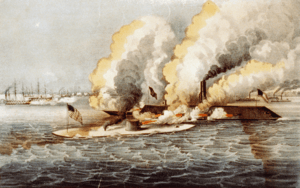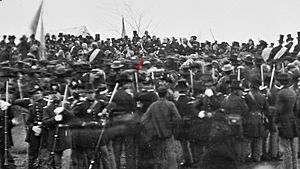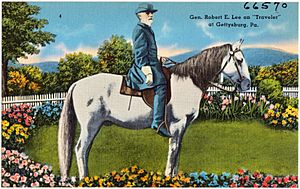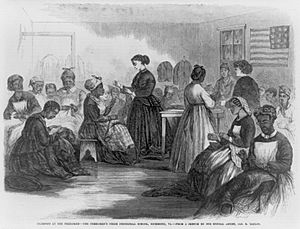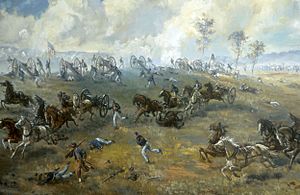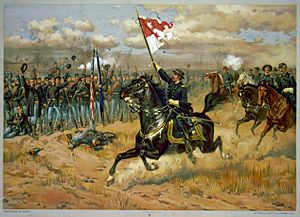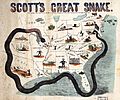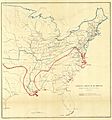American Civil War facts for kids
The American Civil War (1861–1865) was a civil war in the United States of America. It is sometimes called "The War Between the States." The war was fought because eleven Southern states wanted to leave the United States of America. They formed the Confederate States of America, also called "the Confederacy." The U.S. government and the states that remained loyal to it were called "the Union."
One cause of the war was slavery. Slavery was common in the Southern states, including all 11 that joined the Confederate states. It was illegal in most of the Northern states. The Confederate states tried to leave the Union after Abraham Lincoln, who disliked slavery, was elected President of the United States. The Union believed that it was illegal for the states to break away. Five states where slavery was legal stayed in the Union. These were called the "border states." The Union did not plan to abolish slavery at first, but in 1862, this became one of their goals.
The war began on April 12, 1861, when Confederate forces attacked Fort Sumter, a fort in South Carolina held by Union soldiers. The war lasted four years and caused much damage in the South. Until 1862, the war was fought mostly in the Northern states, but afterward, it was mostly fought in the Southern states. After four years of fighting, the Union won the war. After the Union won, slavery was made illegal everywhere in the United States.
Contents
Background
When the United States of America was founded in 1776, most states allowed slavery. But over the next 84 years, the Northern states decided that slavery was a bad thing and banned it. The Southern states kept slavery legal. Plantation owners grew cotton in those states, which made a lot of money. They used slaves from Africa to harvest the cotton.
The United States became divided into slave and free states. By 1860, those states had long been growing more angry at each other. They had been arguing over whether slavery should be allowed in the lands to the west. In the late 1850s, there was fighting in Kansas between people who wanted to allow slavery in the Kansas area and people who wanted it banned.
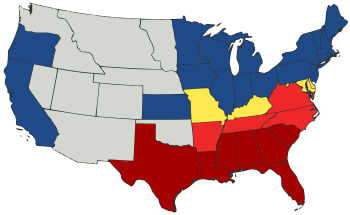
Abraham Lincoln from the Republican Party won the 1860 United States presidential election. Lincoln did not yet want to ban slavery. He thought that banning it would damage the South. But Lincoln and the Republican Party disliked slavery and did not want it to spread to the west.
Lincoln became president on March 4, 1861. After the election, seven Southern states declared their independence from the Union. The outgoing U.S. president, James Buchanan, said this was against the law but did nothing to stop them. Lincoln and his Republican party treated this secession as a rebellion. No country ever recognized the Confederacy as a separate nation. This was because of diplomacy on the part of the Union, anti-slavery feelings in Europe, and the northern blockade of southern ports.
The first seven states to join the Confederacy were South Carolina, Mississippi, Florida, Alabama, Georgia, Louisiana, and Texas. Four others joined after fighting began: Virginia, Arkansas, Tennessee, and North Carolina. The Confederacy claimed Kentucky and Missouri belonged to them, but these states never joined the Confederacy. Kentucky, Missouri, and Maryland were slave states that tried to avoid taking sides. Delaware supported the Union despite being a slave state. Also, the western counties of Virginia chose to remain in the Union, creating a new state called West Virginia.
Fighting begins
Fighting started when the Confederates bombarded Fort Sumter, a Union Army fort. The Confederate States claimed that they owned all forts and other federal buildings in the South. Fort Sumter was in South Carolina - one of the Confederate States. However, the fort was controlled by the Union. On April 12, 1861, Confederate forces attacked the fort. They forced the Union soldiers inside the fort to surrender. After this, President Lincoln asked every Union state for volunteers to join the Union Army. Quickly, four more southern slave states joined with the Confederates instead of supplying forces to fight them.
The war
The American Civil War was fought in three important land areas, or "theaters:"
- The Eastern theater included all land east of the Appalachian Mountains.
- The Western theater included all land between the Appalachian Mountains and the Mississippi River and along the river.
- The Trans-Mississippi theater included land west of the Mississippi river.
Both the Union and the Confederacy had their capital cities in the Eastern theater. Washington D.C. had been the capital of the U.S. since 1800. When the South seceded, it first named Montgomery, Alabama, as the capital of the Confederate States, but soon changed to Richmond, Virginia. Richmond and Washington are only about 90 miles (145 km) apart. One of the first battles of the war was fought in Virginia. This First Battle of Bull Run happened on July 21, 1861. The Confederates won the battle. The Union Army of the Potomac then tried to capture Richmond in the Peninsula Campaign during the spring of 1862. At this time, Robert E. Lee took command of the Army of Northern Virginia and defeated the Union army. He then won the Second Battle of Bull Run in August 1862. Lee tried to win the war by invading Maryland. When he lost the Battle of Antietam, he retreated back to Virginia.
There was much naval warfare in the American Civil War, but the Union navy was much stronger. Lincoln put the Confederates under a blockade, which meant the United States Navy would not let any ships into or out of southern ports. The blockade stopped the Confederacy from selling its cotton and other goods. It also made it harder for them to buy weapons and military supplies. The Confederates used ships called blockade runners to bring things from Europe. The things the Confederates brought included weapons. The navies of each side also fought on the rivers. The ships included ironclads, which were protected by iron on their sides, and cottonclads, which used cotton along its sides. During the Battle of Hampton Roads, the Confederate ironclad Virginia fought against the Union ironclad Monitor. This was the first time in world history that two ironclads fought each other.
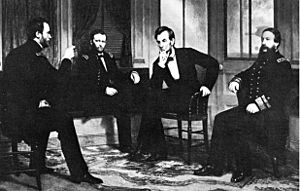
In the Western theater, much of the fighting happened along the Mississippi River. Ulysses S. Grant was an important Union general in the west. The Confederates tried to send their soldiers into the state of Kentucky during the summer of 1861. During the early months of 1862, the Union army made the Confederates retreat from Kentucky and from western Tennessee. The Confederates tried to recapture western Tennessee by attacking Grant's army at the Battle of Shiloh. Grant won the battle. The Confederates then tried to send their soldiers into eastern Kentucky during the fall of 1862. They left Kentucky after losing the Battle of Perryville.
The North won control of almost all of the Mississippi River. This was by capturing the cities along the river during the fall of 1862 and spring of 1863. However, the Confederacy still held Vicksburg, an important city and fort. If they held the city, the Confederates could move soldiers and supplies from one side of the river to the other. Grant started the Siege of Vicksburg in May 1863. The siege continued for a long time. On July 4, 1863, the Confederates in Vicksburg surrendered to Grant. This was one of the turning points in the war, because it divided the Confederacy into two parts.
There were also battles west of the Mississippi River Valley, in the Trans-Mississippi theatre. For example, two important battles were the Battle of Wilson's Creek and the Battle of Pea Ridge. The Confederates tried to invade New Mexico during February and March 1862, but they were defeated at the Battle of Glorieta Pass. After the Union captured Vicksburg, this area became separated from the rest of the Confederate states. Other battles happened in this area after the capture of Vicksburg.
During the siege of Vicksburg in the west, another turning point came in the east. After winning some battles, Lee decided to invade the North again. Lee and his Army of Northern Virginia went into Pennsylvania. The Confederate Army met the Union Army near Gettysburg, Pennsylvania. The two armies fought the Battle of Gettysburg. This battle lasted for three days: July 1 to 3, 1863. More soldiers died at Gettysburg than in any other Civil War battle. The Union won the battle. This stopped the Confederate Army's invasion into the North. Lee and his troops were pushed back into the South.
After this, President Lincoln decided that Grant was his best general. He put Grant in control of all the Union armies. Lincoln also made William T. Sherman the general in charge of the Union troops in Georgia. Grant led many attacks on Lee's army. These battles were made up the Overland Campaign. Meanwhile, Sherman burned Atlanta and Savannah. He did this to try to make the South weaker and to make it harder for Southern people to supply the Confederate Army with food and other necessities. Sherman then marched north through South Carolina and North Carolina. Confederate general Joseph E. Johnston attacked Sherman at the Battle of Bentonville. Sherman won the battle.
Lee held out as long as he could in Virginia. Eventually he decided that he had too few soldiers to keep on fighting the Union, which had more soldiers and supplies. Lee surrendered to Grant on April 9, 1865, near Appomattox Court House. After Lee surrendered, many other Confederate armies surrendered also. The last Confederate general to surrender was Brigadier General Stand Watie. He surrendered on June 23, 1865, in Oklahoma.
After the war ended, President Lincoln pardoned all of the Confederate soldiers. This meant the Confederate soldiers would not be arrested or punished for fighting against the Union. The southern states would be allowed to rejoin the United States again. However, some Confederates did not want to return to the United States. Some of these people moved to México or Brazil.
Inflation
During the war, inflation was a problem in the Union and a bigger problem in the Confederacy, whose government paid for the war by printing a large amount of paper money. Prices went up and everything became more expensive. Many people could not afford the higher prices and went hungry because of this. This was one thing that helped lead to the Confederacy's surrender.
After the war
Many soldiers on both sides died during the war. Most of the war was fought in the South. Many railroads, farms, houses, and other places were destroyed, and most people there became very poor. The period after the war, called Reconstruction, lasted from the end of the war until 1877. The Union Army stayed in some Southern states, making them occupied territory. Three important amendments were added to the United States Constitution. The amendments were proposed (or suggested) by the U.S. government. Although not every American supported them, the amendments got enough support to pass:
- The 13th Amendment said that slavery is not allowed anywhere in the United States. This completed the work of the Emancipation Proclamation.
- The 14th Amendment made it clear that all people born in the United States were citizens with equal rights.
- The 15th Amendment said that people in the United States could not be kept from voting because of their race.
After the war, some of the Union Army's leaders went into politics. Generals Grant, Hayes, Garfield, Harrison, and McKinley became presidents. Other veterans were elected to other offices.
The Amnesty Act of 1872 restored the rights to vote and to hold political office for most of the former members of the Confederacy. Some of them also became politicians.
Battles
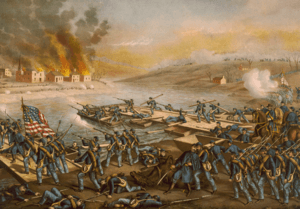
- First Battle of Bull Run
- Second Battle of Bull Run
- Battle of Gettysburg
- Siege of Petersburg
- Battle of Atlanta
- Battle of Antietam
- Battle of Chancellorsville
- Battle of Fort Henry
- Battle of Fort Hindman
- Battle of Fort Sumter
- Battle of Fredericksburg
- Battle of Nashville
- Battle of Pea Ridge
- Battle of Perryville
- Battle of Seven Pines
- Battle of Shiloh
- Battle of Vicksburg
Interesting facts about the American Civil War
- About one-third of the Union army were immigrants.
- Those drafted during the Civil War were allowed to pay someone $300 to fight in their place.
- Of the nearly three million soldiers in the Civil War, most were volunteers.
- Some people pulled their front teeth because possessing opposing front teeth (to open gunpowder pouches) was required to fight in the Civil War.
- The oldest man to fight in the Civil War was an 80-year-old man from Iowa, and the youngest was an 11-year-old boy from Mississippi.
- Black soldiers were paid less than white soldiers, so they arranged a strike that lasted 18 months. The strike worked, and with the support of abolitionists, they received equal pay in 1864 that paid back to when they started as soldiers.
- Both a Union General and the Confederate President were named Jefferson Davis.
- Abraham Lincoln was in favor of colonization. He wanted freed black people to be deported to Central America.
- Harriet Tubman helped lead a raid along the Combahee River and used the chaos to free over 720 slaves.
- P. luminescens, a luminescent bacterium that produces a natural antibiotic, is reported to have been seen by soldiers from both sides of the war. They said that the soldiers with wounds that seemed to glow healed faster than those whose wounds did not glow.
- Generals were more likely to die in battle than privates because they led their soldiers into battles.
- Generals Thomas Leonidas Crittenden and George Crittenden were brothers who fought on opposite sides of the war.
- Robert E. Lee’s estate, known as Arlington, was seized for nonpayment in taxes and later used as the famous Arlington National Cemetery.
- Two percent of the American population died during the Civil War, with two-thirds of those dying from disease.
- Every student from the University of Mississippi who joined the Confederate Army died during the war.
- General Ambrose Burnside inspired the term “sideburns.”
- After the war, inflation caused the value of the Confederate dollar to plummet. It took 1200 Confederate dollars to buy one U.S. dollar.
- W.V. Meadows, who was shot in the eye during the Battle of Vicksburg, survived and coughed the bullet out of his mouth 58 years later.
Related Pages
- Causes of the American Civil War
- African Americans in the American Civil War
- Confederate States of America
- Abraham Lincoln
- Jefferson Davis
- Robert E. Lee
- United States Constitution
- 13th Amendment
- 14th Amendment
- Reconstruction
Images for kids
-
Uncle Tom's Cabin by Harriet Beecher Stowe, aroused public opinion about the evils of slavery. According to legend, when Lincoln was introduced to her at the White House, his first words were, "So this is the little lady who started this Great War."
-
Frederick Douglass, a former slave, was a leading abolitionist
-
The Battle of Fort Sumter, as depicted by Currier and Ives.
-
Rioters attacking a building during the New York anti-draft riots of 1863
-
Clashes on the rivers were melees of ironclads, cottonclads, gunboats and rams, complicated by naval mines and fire rafts.
-
Battle between the USS Monitor and Merrimack
-
General Scott's "Anaconda Plan" 1861. Tightening naval blockade, forcing rebels out of Missouri along the Mississippi River, Kentucky Unionists sit on the fence, idled cotton industry illustrated in Georgia.
-
Gunline of nine Union ironclads. South Atlantic Blockading Squadron off Charleston. Continuous blockade of all major ports was sustained by North's overwhelming war production.
-
A December 1861 cartoon in Punch magazine in London ridicules American aggressiveness in the Trent Affair. John Bull, at right, warns Uncle Sam, "You do what's right, my son, or I'll blow you out of the water."
-
County map of Civil War battles by theater and year
-
"Stonewall" Jackson got his nickname at Bull Run.
-
The Battle of Antietam, the Civil War's deadliest one-day fight.
-
Albert Sidney Johnston died at Shiloh
-
By 1863, the Union controlled large portions of the Western Theater, especially areas surrounding the Mississippi River
-
The Battle of Chickamauga, the highest two-day losses
-
Nathaniel Lyon secured St. Louis docks and arsenal, led Union forces to expel Missouri Confederate forces and government.
See also
 In Spanish: Guerra de Secesión para niños
In Spanish: Guerra de Secesión para niños


